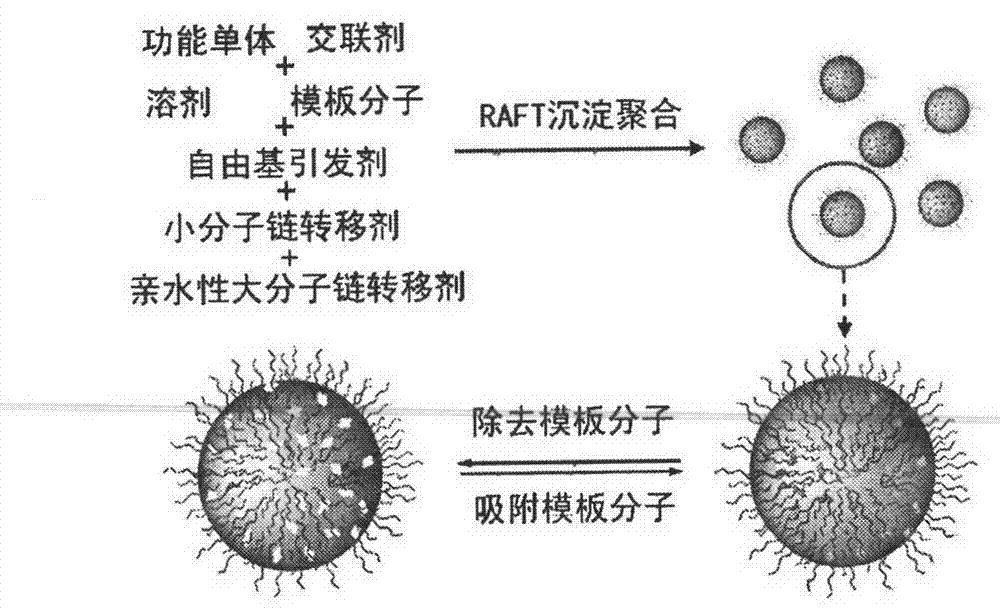Molecularly imprinted polymeric microsphere resin applicable to aqueous solution system and preparing method thereof
A molecular imprinting, polymer technology, applied in the direction of alkali metal compounds, chemical instruments and methods, other chemical processes, etc., can solve problems such as limiting wider applications
- Summary
- Abstract
- Description
- Claims
- Application Information
AI Technical Summary
Problems solved by technology
Method used
Image
Examples
example 1
[0029]Add 0.83mmol of 2,4-D into a 100mL round-bottomed flask filled with 60mL of methanol / water (4:1, v / v), stir it with a magnet to dissolve it completely, and then add 0.83mmol of 4-vinylpyridine. After fully contacting for half an hour, add 2.50mmol EDMA, 0.055mmol small molecular chain transfer agent cumyl dithiobenzoate (CDB), 0.033mmol poly N-isopropylacrylamide macromolecular chain transfer agent and 0.028mmol Azobisisobutyronitrile (AIBN). After deoxygenating with argon for 30 min, the reaction system was sealed, placed in a constant temperature oil bath at 60°C, reacted for 6 h, and the reaction product was obtained by suction filtration.
[0030] The reaction product was washed successively with methanol / acetic acid (9:1, v / v) and methanol until the template-free molecules were washed out. After air-drying, vacuum-dry at 40° C. for 48 hours to obtain molecularly imprinted polymer microspheres with hydrophilic poly-N-isopropylacrylamide polymer brushes on the surfac...
example 2
[0033] Add 0.83mmol of 2,4-D into a 100mL round-bottomed flask filled with 60mL of methanol / water (4:1, v / v), stir it with a magnet to dissolve it completely, and then add 0.83mmol of 4-vinylpyridine. After fully contacting for half an hour, add 2.50mmol EDMA, 0.055mmol small molecule chain transfer agent cumyl dithiobenzoate (CDB), 0.110mmol polyethylene glycol macromolecular chain transfer agent and 0.028mmol azodiiso Nitrile (AIBN). After deoxygenating with argon for 30 min, the reaction system was sealed, placed in a constant temperature oil bath at 60°C, reacted for 10 h, and the reaction product was obtained by suction filtration.
[0034] The reaction product was washed successively with methanol / acetic acid (9:1, v / v) and methanol until no template molecules were washed out. After air-drying, vacuum-dry at 40° C. for 48 hours to obtain molecularly imprinted polymer microspheres with hydrophilic polyethylene glycol polymer brushes on the surface.
[0035] In the prepa...
example 3
[0037] Add 0.25mmol of theophylline into a 250mL round-bottomed flask filled with 100mL of methanol / water (4:1, v / v), stir with a magnet to dissolve it completely, then add 1mmol of methacrylic acid, mix thoroughly for half an hour, and then 4mmol EDMA, 0.09mmol small molecular chain transfer agent CDB, 0.09mmol poly-N-isopropylacrylamide macromolecular chain transfer agent and 0.04mmol AIBN were added successively. After stirring for half an hour, deoxygenate with argon gas for 30 minutes, seal the reaction system, place it in a constant temperature oil bath at 60°C, react for 6 hours, and obtain the reaction product by suction filtration.
[0038] The reaction product was washed successively with methanol / acetic acid (9:1, v / v) and methanol until no template molecule was washed out. After air-drying, vacuum-dry at 40° C. for 48 hours to obtain molecularly imprinted polymer microspheres with hydrophilic poly-N-isopropylacrylamide polymer brushes on the surface.
[0039] In t...
PUM
 Login to View More
Login to View More Abstract
Description
Claims
Application Information
 Login to View More
Login to View More - R&D
- Intellectual Property
- Life Sciences
- Materials
- Tech Scout
- Unparalleled Data Quality
- Higher Quality Content
- 60% Fewer Hallucinations
Browse by: Latest US Patents, China's latest patents, Technical Efficacy Thesaurus, Application Domain, Technology Topic, Popular Technical Reports.
© 2025 PatSnap. All rights reserved.Legal|Privacy policy|Modern Slavery Act Transparency Statement|Sitemap|About US| Contact US: help@patsnap.com



